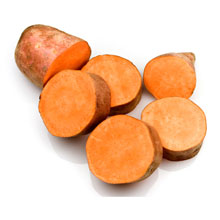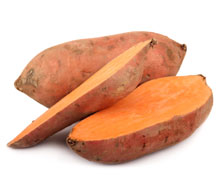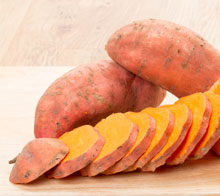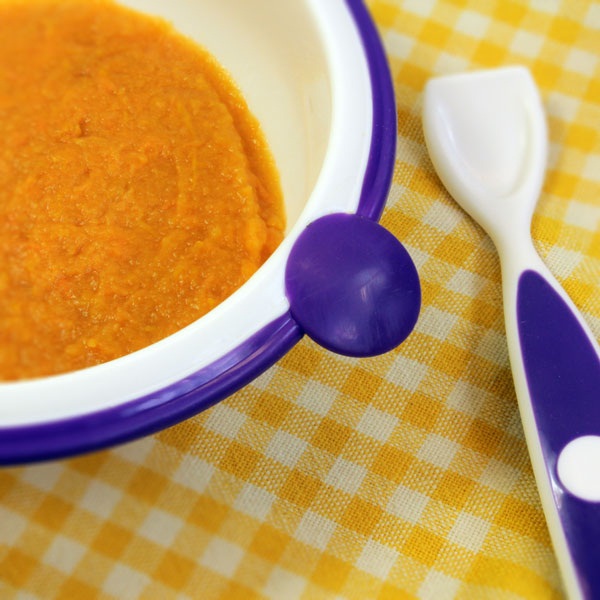Stage 5

- 1 1/2 lbs sweet potatoes, peeled
- 3/4 cup black beans, drained and rinsed
- 1/2 tsp garlic salt
- 1/4 tsp pepper
- 1/2 tsp onion powder
- 1/4 tsp cinnamon
- 1/4 tsp nutmeg
- 1/8 tsp cumin
- Cooking spray
Preheat oven to 400°F.
Steam or boil sweet potatoes until barely tender, approximately 15 minutes. Let cool. Mix potatoes and beans with an immersion blender until smooth. (Add water if needed) Add garlic salt, pepper, onion powder, nutmeg, curry, cumin and cinnamon. Mix well. Spray sheet pans with cooking spray. Using a tablespoon, portion out scoops of mixture and roll slightly, place 1 inch apart on prepared sheet pans. Bake in oven for approximately 10- 12 minutes, until starting to brown. Then flip and bake for approximately 5 minutes or until the both sides start to brown.
Recipe Yields: 6 Servings
Storage Time: 3 days in the refrigerator
Sweet potatoes are an excellent source of potassium, and contains magnesium, and calcium. They also contain vitamins A,C niacin, and folic acid.

Stage 5

- 1 whole sweet potato, cleaned and halved
- 1 1/2 tbsp cheddar cheese
- 1 cup pinto beans, drained and rinsed
- salt and pepper to taste
- Cooking spray
Preheat oven to 400F. Scrub clean and dry a small sweet potato. Cut potato in half and cut the ends off in order to stand the potato up in an oven safe dish, spray the skin of the potato with cooking spray. Bake for 30-40 minutes. Remove from oven and cool slightly. Scoop out the inside of the potato and place in a bowl, mash with Worcestershire, salt and pepper. Mix in most of the cheese and beans (trying to leave the beans whole). Add mixture back into the sweet potato skin, top with remaining cheese. Back for an additional 5-10 minutes.
Recipe Yields: 2 Servings
Storage Time: 3 days in the refrigerator
As a great source of dietary fiber, this recipes also provides vitamins, and protein.

Stage 4 + 5

- 4 oz butter
- 2 lbs peeled diced sweet potatoes, boiled
- 2 red apples peeled, cored and diced
- 2 bananas peeled, diced
- 4 oz orange juice
- 4 oz half and half
- 1/2 cup pecans toasted, chopped (optional)
In large pot melt butter, add potatoes, apples, and banana and sauté lightly. Add orange juice and reduce, add cream and simmer, stirring occasionally until apples and bananas are soft enough to mash. Use a potato masher or electric immersion blender, whip or paddle to puree. Garnish with pecans.
Recipe Yields: 9 Servings
Storage Time: 3 days in the refrigerator
Stage 4
Baked sweet potato chips are a super-easy to prepare and super-healthy snack.
- 2 whole Sweet potatoes, washed & unpeeled
- Salt & pepper, to taste
Preheat oven to 200 degrees. Line a baking sheet with parchment paper.
Slice the unpeeled potato in thin rounds. Arrange the slices on the prepared sheets, and keep them from touching as much as possible. Sprinkle lightly with salt and pepper.
Bake for 45 minutes. Turn chips over and bake for an additional 30-40 minutes. Bake the chips until they are crisp around the edges and slightly soft in the middle (the slices will dry out and shrink as they cook).
Remove from the oven and leave the chips on the baking sheet. Chips will be slightly soft and will crisp as they cool.
Recipe Yields: 4 Servings
Store in an airtight container.
Sweet potatoes are an excellent source of vitamin A and vitamin C.

Stage

The ABCs Of Vitamin C
Vitamin C is critical for health and growth in infancy. This essential vitamin promotes a strong immune system, the growth and maintenance of healthy skin and red blood cells, plus is necessary to build collagen, which helps to form connective tissue that binds muscles, bones, and tissue together. Vitamin C is also known to increase wound healing, while preventing infections and, as an antioxidant, helps protect against diseases such as cancer, heart disease, and arthritis in the future.
While you may have heard these important vitamin C facts from your pediatrician, it may come as a surprise to learn of the many unexpected ways to ensure your little one is getting adequate amounts of vitamins. When baby starts using solid foods as their primary source of nutrition, they should consume foods high in vitamin C daily. Note that most pediatricians suggest infants 7 to 12 months should consume 50 mg. of vitamin C a day, while children 1 to 3 years should have at least 15 mg. a day. To ensure your baby is getting enough vitamin C, try some common (oranges) and uncommon (zucchini) with them. Let’s take a look at some of the common and uncommon sources of vitamin C.
Citrus fruits.
You probably already know about this vitamin C option. Oranges, lemons, grapefruits, and tangerines are just a few of the many types of citrus fruits. They’re well-known for their high vitamin C content. Diluting the juice in water, pureeing, or simply eating the fruit as is-are all excellent ways to introduce your child to these sweet, colorful, and vitamin C-rich foods.
Tomatoes.
Foods like pizza, spaghetti, tomato soup and even ketchup are known to be loved by most little ones. Believe it or not these tomato-based foods are all sure-fire ways to get your little one to sneak in some extra vitamins, including vitamin C! For instance, a 10-ounce serving of tomato soup offers 6.4 mg. of vitamin C. Tomatoes are versatile, try a couple of varieties with your little one to find which they like best.
Sweet potatoes.
This bright and sweet vegetable is ideal for when your baby first begins to eat solids. They contain a wide range of nutrients and can be prepared in a variety of ways. A common way for parents to introduce sweet potatoes is during baby-led weaning, by cooking and mashing them to an appropriate consistency. As your little one progresses in their solid food journey, experiment with different preparations, such as sweet potato French fries.
Cantaloupe.
This child-popular melon is also a great source of vitamin C. A sweet fruit option that can be introduced to baby as soon as they begin eating foods like purees. It’s rich in vitamin C and other essential vitamins. Just one-quarter of a medium cantaloupe features an eye-opening 47 mg. of vitamin C This fruit’s preparation is critical because it can pose a choking hazard if not done correctly.
Watermelon.
Watermelon is a nutritious treat for your little one that is sweet, juicy, and contains approximately 92%1 water. It’s rich in antioxidants, including vitamin C, which can help strengthen baby’s immune system. Like many of the other fruits listed, there is a variety of ways to introduce your little one to this delicious fruit.
Zucchini.
Just one cup on zucchini contains 11 mg. of vitamin C and helps add even more healthy variety to your child’s daily diet. Zucchini can be roasted, steamed, sautéed, or pureed. Pureeing it and making it a sauce with pasta is a sneaky way to sneak this vegetable into your child’s diet (especially if they’re picky).
While offering your toddler a piece of fruit with each meal is a good idea, try introducing other lesser-known sources of vitamin C, such as those listed above, to help provide your toddler with a well-balanced diet that provides multi-vitamin and nutritional benefits.
Stage 3

This recipe is a great source of vitamin A, vitamin C, and protein.
- 2 sweet potatoes, peeled
- 1 tbsp unsalted butter
- 1/4 tsp cinnamon
- 4 oz chicken
Peel, chop and steam sweet potatoes. Cook and chop chicken. Mix together steamed sweet potatoes, chicken, butter and cinnamon. Blend until smooth. Serve warm or freeze.
Recipe Yields: 6 Servings
Store this in an air tight container in the freezer.
Storage Time: 6 months in the freezer
The butter in this recipe helps with absorption of vitamin A. This vitamin is fat soluble which means it needs some fat to be absorbed into the body and fat from the butter will do just that!

Stage 1 + 2

Sweet potato is an excellent source of potassium, and contains magnesium, and calcium. They also contain vitamins A, C niacin, and folic acid.
The ratio of raw to steamed potato is 1:1. One cup of raw potato will make approximately one cup of puree.
Peel the sweet potato and cut it into chunks. Boil or steam the chunks. Cool slightly and then blend with immersion blender. Add breast milk or water to thin the puree to the desired consistency.








